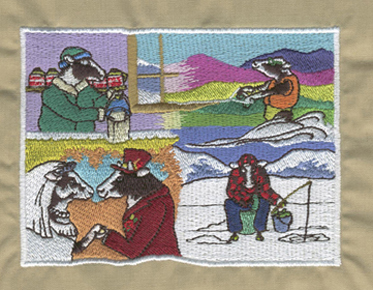Vector Art for Apparel: Bringing Designs to Life
In the dynamic world of fashion and apparel design, the importance of creating visually stunning and versatile designs cannot be overstated. Vector art has emerged as a game-changer in this realm, offering designers the tools to bring their creative visions to life with precision, scalability, and unparalleled flexibility. In this blog, we'll delve into the significance of vector art in the apparel industry, exploring its features, benefits, and how it enhances the design process for clothing and accessories.
Understanding Vector Art in
Apparel Design
1. Definition of Vector Art:
Vector art is a digital illustration created
using mathematical equations rather than fixed pixels. This format allows for
the creation of graphics that are infinitely scalable without losing quality.
In the context of apparel design, vector graphics are instrumental in creating
intricate and detailed designs for various garments.
2. Key Features of Vector Art:
● Scalability: Vector graphics can be resized without
any loss of quality, making them ideal for apparel design where designs may
need to be adapted for different garment sizes.
● Detail and Precision: Vector art allows designers to achieve intricate details and precise
lines, ensuring that the final apparel design is visually appealing and
accurately represents the intended concept.
● Color Consistency: Vector graphics maintain consistent colors across different applications, a crucial aspect when translating designs onto various apparel items.
The Role of Vector Art in Apparel
Design
1. Customization and Personalization:
● Tailored Designs: Vector art enables designers to create customized and personalized
designs for apparel. Whether it's adding individual names, unique patterns, or
personalized messages, vector graphics make customization seamless.
2. Logo and Branding:
● Consistent Branding: Apparel is a powerful canvas for brand expression. Vector logos ensure
that branding elements maintain consistency across different clothing items,
reinforcing brand identity.
3. Textile Design:
● Intricate Patterns: Vector art is pivotal in textile design, allowing designers to create
intricate patterns and motifs that can be seamlessly repeated across fabrics.
This is particularly valuable in the creation of unique and eye-catching
apparel.
4. Typography and Lettering:
● Crisp Typography: Whether it's a catchy slogan or intricate lettering, vector art ensures
that typography remains crisp and clear on apparel. This is especially
important for designs that rely on impactful text elements.
5. Versatility in Design Elements:
● Icons and Graphics: Vector graphics enable the inclusion of various design elements such
as icons, symbols, and graphics. These elements can be easily integrated into
apparel designs, adding visual interest and enhancing the overall aesthetic.
6. Multicolor Designs:
● Vibrant Color Palette: Vector art allows for the use of a vibrant and diverse color palette. This is particularly advantageous for apparel designers looking to create eye-catching and lively designs that stand out.
Best Practices for Using Vector
Art in Apparel Design
1. Start with Vector Software:
● Adobe Illustrator: Utilize vector editing software like Adobe Illustrator for creating
and editing vector graphics. Illustrator provides a robust set of tools
specifically designed for vector-based design.
2. Consider Printing Techniques:
● Understand Printing Methods: Be mindful of the printing techniques that will be used for the
apparel. Different methods may have specific requirements, and vector art
allows for easy adaptation to these needs.
3. Vectorize Logos and Elements:
● Convert Logos to Vectors: Ensure that logos and essential design elements are in vector format
to maintain clarity and sharpness, especially when resized for different
apparel items.
4. Test Color Variations:
● Explore Color Combinations: Vector art allows for easy experimentation with color combinations.
Test different variations to find the most visually appealing and impactful
color scheme for the apparel design.
5. Maintain Editable Files:
● Save Editable Versions: Keep editable versions of your vector files. This allows for quick modifications or adaptations as needed, especially if there are changes in the design or if it needs to be adjusted for different apparel items.
Vector Art and the Future of
Apparel Design
As technology advances and consumer preferences evolve, vector art is set to play an even more crucial role in shaping the future of apparel design. The demand for personalized and unique clothing items is on the rise, and vector graphics provide designers with the tools to meet these expectations efficiently.
Conclusion
In the competitive
landscape of apparel design, where creativity, precision, and adaptability are
paramount, vector art stands as a cornerstone
for designers. Its scalability, versatility, and ability to maintain quality
across various applications make it an indispensable tool for bringing apparel
designs to life. From intricate patterns to bold typography, vector art
empowers designers to create garments that not only look visually stunning but
also communicate a brand's identity and resonate with the diverse preferences
of consumers. In the dynamic realm of fashion, vector art proves to be the key
to unlocking limitless creative possibilities and setting trends that captivate
audiences worldwide.



